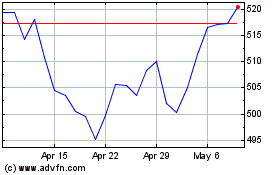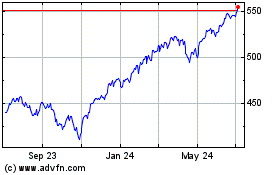Although the markets have started the year on a solid note,
significant amounts of volatility remain in equities. Huge issues
hang over the market—be it in the form of job creation, Iranian
worries, or European woes—and any one of these problems could
derail growth later this year.
Thanks to this and the impressive pace of the market’s gains so
far this year, some investors may be considering dialing back
exposure to the broad markets, or at least taking a closer look at
more defensive choices instead. This strategy could be ideal for
those seeking to lock in some gains or those who are forecasting a
long slump or a return to more stable markets in the second quarter
(see more on ETFs in the Zacks ETF Center).
One way to accomplish this task while still maintaining exposure
to the broad markets is via the relatively new Trendpilot ETNs.
These innovative notes from RBS utilize a systematic
trend-following strategy which can help to cut down on losses,
assuming that trends hold.
Trendpilot ETN Methodology Explained
In essence, the strategy consists of two components; a broad
benchmark and a Treasury bond component. When the broad
benchmark—or main asset—is at or above its 200 day simple moving
average for five consecutive days, a positive trend is established.
When this takes place, the note will be fully allocated to the
broad benchmark or asset in question.
However, when the index is in a bearish trend—the benchmark is
trending below its 200 day simple moving average for five
consecutive days—the product will establish a more defensive
position. This means the product will cycle out of its stock index
or asset and focus in on T-Bills until a positive trend is once
again established (read Three Outperforming Active ETFs).
With this focus, the Trendpilot ETNs look to avoid the downtimes
in a particular market segment and only invest in a sector when it
is trending higher. This can help to avoid losses but sometimes the
five day level may be too quick of a time period for some trends to
develop.
ETN Ramifications
Investors should also note that the products are structured as
ETNs as opposed to exchange traded funds. This is an important
distinction for trend following products that cycle quickly in and
out of different asset classes (also read ETFs vs. ETNs: What’s The
Difference?).
Basically, ETNs don’t actually hold any securities; instead they
are unsecured senior debt obligations from the issuing institution.
This means that when the trend cycles from one product to another
it just shifts which index it is tracking, nothing is actually
bought or sold. Thanks to this, tracking error for these products
looks to be non-existent, something that cannot be said for
implementing a similar strategy on your own.
The main downsides to the technique are cost and volume.
Currently, of the five Trendpilots, not a single one has more than
$70 million in AUM while three have less than $10 million in
assets.
Additionally fees are quite high compared to similar non-trend
following products; depending on the asset being tracked fees can
reach 100 basis points and only go down to 50 basis points a year
when products are tracking T-Bills instead.
While the strategy certainly sounds interesting, it clearly has
it downsides as well. As a result, the real test for the Trendpilot
products should be when investors put them up against more
traditional rivals. Below, we take a look at the five Trendpilot
ETNs and see how they have done against their more popular
counterparts over the past 52 week period:
RBS Gold Trendpilot ETN (TBAR)
This ETN applies the Trendpilot methodology to gold, as measured
by the spot price of the afternoon gold fixing price for good
delivery in London. The ETN currently has $25 million in AUM and
sees trading volume of about 12,000 shares each day (see ETF
Investors: Beware The Coming ETN Backlash).
For comparison purposes, GLD is easily the most
popular fund tracking the pure gold space, although it is always
focused on the precious metal. This has proven to be a winning
strategy over the past 12 months as GLD has outperformed TBAR by a
little over 375 basis points. If you add in the fee differential,
it becomes even greater putting GLD’s outperformance over the 400
bps mark.
RBS NASDAQ-100 Trendpilot ETN (TNDQ)
For a more tech focused play using the Trendpilot methodology,
investors should take a closer look at TNDQ. The ETN cycles between
the Nasdaq-100 and T-Bills, either giving exposure to short-term
government debt or a tech focused index which includes the likes of
Apple (AAPL), Microsoft (MSFT),
and Google (GOOG).
An easy comparison between this ETN and a more traditional
product is that of QQQ. This ultra-popular ETF has
added about 21.3% in the past 52 weeks compared to a 19.4% return
for TNDQ in the same time period.
While QQQ has been the better choice over the long term, TNDQ
has actually outperformed over the past three month period. The
fund avoided a great deal of turmoil in early March and had a great
start to the year, allowing the note to outperform QQQ by about 480
basis points in the first quarter.
RBS Oil Trendpilot ETN (TWTI)
In order to play the crude oil market, investors can also
consider RBS’ TWTI. The note targets WTI Crude oil, focusing on the
12 contracts that are closest to expiration along the curve.
Investors should also note that this product has a slightly higher
expense ratio at 1.1% and that it looks at a trailing 100 level to
determine its baseline.
One of the more popular oil ETFs that could be a competitor is
the United States Oil Fund (USO). The product also
targets WTI crude, and over the past 52 weeks has gained just over
13.5%. This easily beats out TWTI’s 9.7% gain in the same time
frame, especially when factoring in expenses (see Is An Oil Sands
ETF On The Horizon?).
However, in the recent one month period TWTI has easily
outperformed USO and a similar trend took place over the past
quarter. Still, investors should note that over the past six
months, thanks to TWTI slowly cycling into crude oil, the product
missed out on a lot of gains and underperformed significantly from
this time frame (also, the product has outperformed
USL over the past three month period. Arguably,
this fund is a better comparison but hasn’t been around long enough
to do a full year study).
RBS US Large Cap Trendpilot ETN (TRND)
Easily the most popular Trendpilot product is TRND which focuses
in on large cap U.S. stocks that make up the S&P 500 index. The
product has accumulated nearly $70 million in AUM and trades a
respectable 20,000 shares a day.
For comparison purposes, investors can look to
SPY, the most popular ETF in the world. This fund
also focuses in on the S&P 500 but does not have the T-Bill
component like TRND. Although SPY has been much more volatile—and
was a bigger loser in the worst of 2011—the fund has come roaring
back and is now easily beating TRND over the past year, outgaining
the fund 5% to -1.9%.
RBS US Mid Cap Trendpilot ETN (TRNM)
The second most popular Trendpilot ETN is TRNM, a product with a
mid cap focus. This note looks to cycle between 3-month U.S.
Treasury bills and the S&P Mid Cap 400 Total Index, a benchmark
that comprises roughly 7% of the American equity market (see Mid
Cap ETF Investing 101).
A major non-trend following competitor of TRNM is iShares’
IJH. The product follows the S&P Mid Cap 400
and currently has over $10 billion in AUM. Much like other products
on this list, IJH has thoroughly crushed its Trendpilot
counterpart, losing 1.6% over the past year compared to a 12.6%
loss for TRNM. The note did have less of a total drawdown though,
so it could be a better choice for restless investors, although it
was a little late to the party when the market moved higher.
Thanks to these trends, investors should think twice about the
Trendpilot methodology. While the products are undoubtedly
interesting, the fees are quite high and they can lag in bull
markets. Yet, with that being said, bear markets and those with
clear trends seem to serve this strategy well, so if you believe
the market will face either of these situations, the segment could
be worth a closer look.
Want the latest recommendations from Zacks Investment Research?
Today, you can download 7 Best Stocks for the Next 30
Days. Click to get this free report >>
To read this article on Zacks.com click here.
Zacks Investment Research
Want the latest recommendations from Zacks Investment Research?
Today, you can download 7 Best Stocks for the Next 30 Days. Click
to get this free report
SPDR S&P 500 (AMEX:SPY)
Historical Stock Chart
From Mar 2024 to Apr 2024

SPDR S&P 500 (AMEX:SPY)
Historical Stock Chart
From Apr 2023 to Apr 2024
